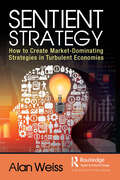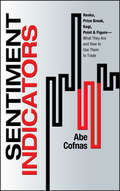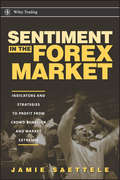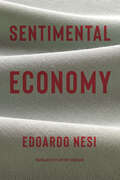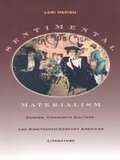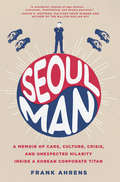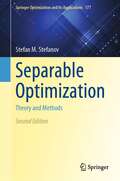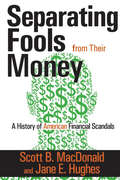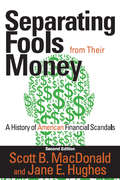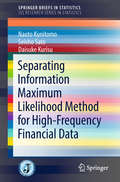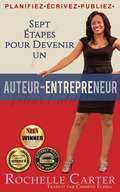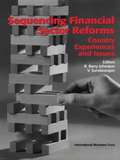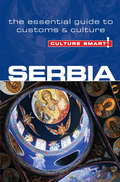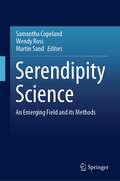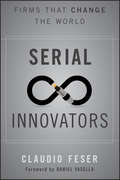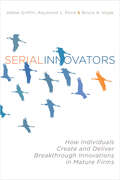- Table View
- List View
Sentient Strategy: How to Create Market-Dominating Strategies in Turbulent Economies
by Alan WeissNo pre-pandemic strategy is effective anymore. None. Not for organizations large or small, for-profit or non-profit, domestic or global. Claims of a "return to normal" or "the new normal" are ridiculous. What we’re facing is really a "new reality," and that reality is the need for agile strategic decisions and pragmatic views of the future. That means that strategy formulation can be reduced to a few days and the view of the future can only be 12–18 months. This is the antithesis of Peter Drucker’s approach to strategy, but his highly effective approach was developed at GM three quarters of a century ago. It’s time to move on. Alan Weiss has developed an original and completely new approach to strategy which thus far has certified over 100 people globally, delivering this approach to scores of firms of all types in four countries. More than two dozen firms are using this approach. Sentient Strategy is based on two modern dimensions: awareness of the environment in which the organization exists and has influence, and consciousness of the impact of actions being considered. The old SWOT (strengths, weaknesses, opportunities, threats) approaches are currently equivalent to riding down the freeway on a horse. We must drop the hubris that has led us to believe we can see years ahead and anticipate what’s coming. No one predicted the Internet No one predicted the latest pandemic. It’s time to turn volatility and disruption on their heads and use them as offensive weapons in the marketplace instead of trying to protect ourselves from them. Imagine a strategy that an organization can formulate in just a day or so, revisit easily and frequently, and design a series of shorter-term, viable futures. "Sentient" means "perceptive" and "self-aware." It doesn’t mean "one size fits all" from a cookie-cutter firm’s approach to strategy. Alan Weiss equips the reader to consider using this approach independently. These are new times—a new reality, a "no normal™"—hence, it’s ridiculous to use old approaches to strategy. There’s a clear reason why Sears didn’t morph into Amazon and why Hertz surrendered its number one spot to Enterprise.
Sentiment Indicators: Renko, Price Break, Kagi, Point and Figure - What They Are and How to Use Them to Trade (Bloomberg #124)
by Abe CofnasA practical guide to profiting from the proper use of sentiment indicators In Sentiment Indicators, noted trading expert Abe Cofnas draws on his own trading and training experience as he shares his knowledge about the latest techniques and strategies for using Renko, price break, Kagi, and point and figure tools to successfully analyze all markets. Written with the serious trader in mind, Sentiment Indicators offers key information on these potential-filled tools and how to use each in shaping trading strategies. Along the way, it provides a practical overview of how to implement these little-known indicators and why each can enhance your trading endeavors. Shows how these indicators work in different markets: futures, equities, forex, and others Provides a solid understanding of charting techniques and uses real-world examples to illustrate strategies and tactics Presents new sentiment research that analyzes word mining and what it means for markets From historical context and Robot Trading alerts to the critical factors of a trading system, Sentiment Indicators presents a proven approach to trading that will help you identify conditions that have a high probability of profit.
Sentiment in the Forex Market
by Jamie SaetteleCrowds move markets and at major market turning points, the crowds are almost always wrong. When crowd sentiment is overwhelmingly positive or overwhelmingly negative ? it's a signal that the trend is exhausted and the market is ready to move powerfully in the opposite direction. Sentiment has long been a tool used by equity, futures, and options traders. In Sentiment in the Forex Market, FXCM analyst Jaime Saettele applies sentiment analysis to the currency market, using both traditional and new sentiment indicators, including: Commitment of Traders reports; time cycles; pivot points; oscillators; and Fibonacci time and price ratios. He also explains how to interpret news coverage of the markets to get a sense of when participants have become overly bullish or bearish. Saettele points out that several famous traders such as George Soros and Robert Prechter made huge profits by identifying shifts in crowd sentiment at major market turning points. Many individual traders lose money in the currency market, Saettele asserts, because they are too short-term oriented and trade impulsively. He believes retail traders would be much more successful if they adopted a longer-term, contrarian approach, utilizing sentiment indicators to position themselves at the beginning points of major trends.
Sentiment, Reason, and Law: Policing in the Republic of China on Taiwan (Police/Worlds: Studies in Security, Crime, and Governance)
by Jeffrey T. MartinWhat if the job of police was to cultivate the political will of a community to live with itself (rather than enforce law, keep order, or fight crime)? In Sentiment, Reason, and Law, Jeffrey T. Martin describes a world where that is the case.The Republic of China on Taiwan spent nearly four decades as a single-party state under dictatorial rule (1949–1987) before transitioning to liberal democracy. Here, Martin describes the social life of a neighborhood police station during the first rotation in executive power following the democratic transition. He shows an apparent paradox of how a strong democratic order was built on a foundation of weak police powers, and demonstrates how that was made possible by the continuity of an illiberal idea of policing. His conclusion from this paradox is that the purpose of the police was to cultivate the political will of the community rather than enforce laws and keep order.As Sentiment, Reason, and Law shows, the police force in Taiwan exists as an "anthropological fact," bringing an order of reality that is always, simultaneously and inseparably, meaningful and material. Martin unveils the power of this fact, demonstrating how the politics of sentiment that took shape under autocratic rule continued to operate in everyday policing in the early phase of the democratic transformation, even as a more democratic mode of public reason and the ultimate power of legal right were becoming more significant.
Sentimental Economy
by Edoardo NesiIn a warm, perceptive essay that touches on economics, fashion, literature, and politics, the Strega Prize–winning author of Story of My People reflects on the seismic shifts of 2020 and the diverse ways we&’re adapting.Attempting to make sense of the incredible upheaval of 2020—from the devastating impact of COVID-19 to the sudden loss of his father—Edoardo Nesi considers the changing global economy and its effect on our lives. He shares the stories of Alberto Magelli, a small textile entrepreneur; Livia Firth, a prominent advocate for sustainability; Elisa Martelli, a young Sangiovese winemaker; Enrico Giovannini, a leading economist and statistician; Rino Pratesi, a proud butcher from the heart of Tuscany; and more. From the overworked to the unemployed, we&’re all grappling with difficult questions about our current disorienting world: Will we ever feel healthy again, and what will it take to regain &“normality?&” What does progress mean today? Have science and technology let us down? What will the increased prevalence of remote working mean for our cities, and for our lifestyles generally? Deftly weaving together the personal and the economic, Nesi takes us on a fascinating journey to understanding.
Sentimental Materialism: Gender, Commodity Culture, and Nineteenth-Century American Literature
by Lori MerishIn Sentimental Materialism Lori Merish considers the intricate relationship between consumption and womanhood in the late eighteenth and nineteenth centuries. Taking as her starting point a diversity of cultural artifacts--from domestic fiction and philosophical treatises to advice literature and cigars--Merish explores the symbolic functions they served and finds that consumption evolved into a form of personal expressiveness that indicated not only a woman's wealth and taste but also her race, class, morality, and civic values. The discursive production of this new subjectivity--the feminine consumer--was remarkably influential, helping to shape American capitalism, culture, and nation building.The phenomenon of female consumption was capitalism's complement to male production: It created what Merish calls the "Other Protestant Ethic,"a feminine and sentimental counterpart to Max Weber's ethic of hard work, economic rationality, and self-control. In addition, driven by the culture's effort to civilize the "cannibalistic" practices of ethnic, class, and national otherness, appropriate female consumerism, marked by taste and refinement, identified certain women and their families as proper citizens of the United States. The public nature of consumption, however, had curiously conflicting effects: While the achievement of cultured material circumstances facilitated women's civic agency, it also reinforced stereotypes of domestic womanhood.Sentimental Materialism's inquiry into middle-class consumption and accompanying ideals of womanhood will appeal to readers in a variety of disciplines, including American studies, cultural studies, feminist theory, and cultural history.
Seoul Man: A Memoir of Cars, Culture, Crisis, and Unexpected Hilarity Inside a Korean Corporate Titan
by Frank AhrensRecounting his three years in Korea, the highest-ranking non-Korean executive at Hyundai sheds light on a business culture very few Western journalists ever experience, in this revealing, moving, and hilarious memoir.When Frank Ahrens, a middle-aged bachelor and eighteen-year veteran at the Washington Post, fell in love with a diplomat, his life changed dramatically. Following his new bride to her first appointment in Seoul, South Korea, Frank traded the newsroom for a corporate suite, becoming director of global communications at Hyundai Motors. In a land whose population is 97 percent Korean, he was one of fewer than ten non-Koreans at a company headquarters of thousands of employees.For the next three years, Frank traveled to auto shows and press conferences around the world, pitching Hyundai to former colleagues while trying to navigate cultural differences at home and at work. While his appreciation for absurdity enabled him to laugh his way through many awkward encounters, his job began to take a toll on his marriage and family. Eventually he became a vice president—the highest-ranking non-Korean at Hyundai headquarters.Filled with unique insights and told in his engaging, humorous voice, Seoul Man sheds light on a culture few Westerners know, and is a delightfully funny and heartwarming adventure for anyone who has ever felt like a fish out of water—all of us.
Separable Optimization: Theory and Methods (Springer Optimization and Its Applications #177)
by Stefan M. StefanovIn this book, the theory, methods and applications of separable optimization are considered. Some general results are presented, techniques of approximating the separable problem by linear programming problem, and dynamic programming are also studied. Convex separable programs subject to inequality/ equality constraint(s) and bounds on variables are also studied and convergent iterative algorithms of polynomial complexity are proposed. As an application, these algorithms are used in the implementation of stochastic quasigradient methods to some separable stochastic programs. The problems of numerical approximation of tabulated functions and numerical solution of overdetermined systems of linear algebraic equations and some systems of nonlinear equations are solved by separable convex unconstrained minimization problems. Some properties of the Knapsack polytope are also studied. This second edition includes a substantial amount of new and revised content. Three new chapters, 15-17, are included. Chapters 15-16 are devoted to the further analysis of the Knapsack problem. Chapter 17 is focused on the analysis of a nonlinear transportation problem. Three new Appendices (E-G) are also added to this edition and present technical details that help round out the coverage. Optimization problems and methods for solving the problems considered are interesting not only from the viewpoint of optimization theory, optimization methods and their applications, but also from the viewpoint of other fields of science, especially the artificial intelligence and machine learning fields within computer science. This book is intended for the researcher, practitioner, or engineer who is interested in the detailed treatment of separable programming and wants to take advantage of the latest theoretical and algorithmic results. It may also be used as a textbook for a special topics course or as a supplementary textbook for graduate courses on nonlinear and convex optimization.
Separating Fools from Their Money: A History of American Financial Scandals (Separating Fools From Their Money Ser.)
by Scott B. MacDonaldWhat do Michael Milken and Martha Stewart have in common? (Answer: Both became public scapegoats for an outrageous era of greed and excess.) What was the most outrageous party thrown by a financial baron of the twentieth century? (Answer: Tough call, but either Michael Milken's Predators Ball in 1985, or Dennis Kozlowski's Sardinian birthday bash in 2001, with its vodka-spouting sculpture.) Which U.S. war hero president became party to, and victim of, an unabashed con man known as the Napoleon of Wall Street? (Answer: Ulysses S. Grant, but it's a long story.)These questions and more are discussed in Scott MacDonald and Jane Hughes' Separating Fools from Their Money. The authors trace the history of financial scandals from the early days of the young republic through the Enron/WorldCom debacle of modern times. A host of colorful characters inhabit the pages of this history, revealing human nature in all of its dubious shades of gray. At the same time, the book exposes themes common to all financial scandals, which remain astonishingly unchanged over more than two centuries--greed, hubris, media connections, self-interested politicians, and booms-gone-bust, to name a few.Informative and entertaining, Separating Fools should engage the interest of investors and casual business readers, as well as economists interested in supplemental reading for their students.A new introduction focuses on trends since publication of the original, with a postscript on the financial panic of 2008.
Separating Fools from Their Money: A History of American Financial Scandals (Separating Fools From Their Money Ser.)
by Scott B. MacDonaldWhat do Michael Milken and Martha Stewart have in common? What was the most outrageous party thrown by a financial baron of the twentieth century? Which US war hero president became party to, and victim of, an unabashed con man known as the Napoleon of Wall Street?These questions and more are discussed in Separating Fools from Their Money. The authors trace the history of financial scandals beginning with young republic days through the Enron/WorldCom debacle of modern times. Informative and entertaining, this book reveals human nature in all of its dubious shades of grey. It also exposes themes common to all financial scandals, which remain astonishingly unchanged over time greed, hubris, media connections, self-interested politicians, and booms-gone-bust, to name a few.This second edition features a new preface and introduction, plus three new chapters, which address the financial panic of 2008, post-panic scandals, and the "princes of Ponzi." This book's accessible writing will interest the casual business reader as well as the seasoned investor.
Separating Information Maximum Likelihood Method for High-Frequency Financial Data (SpringerBriefs in Statistics #0)
by Naoto Kunitomo Seisho Sato Daisuke KurisuThis book presents a systematic explanation of the SIML (Separating Information Maximum Likelihood) method, a new approach to financial econometrics.Considerable interest has been given to the estimation problem of integrated volatility and covariance by using high-frequency financial data. Although several new statistical estimation procedures have been proposed, each method has some desirable properties along with some shortcomings that call for improvement. For estimating integrated volatility, covariance, and the related statistics by using high-frequency financial data, the SIML method has been developed by Kunitomo and Sato to deal with possible micro-market noises.The authors show that the SIML estimator has reasonable finite sample properties as well as asymptotic properties in the standard cases. It is also shown that the SIML estimator has robust properties in the sense that it is consistent and asymptotically normal in the stable convergence sense when there are micro-market noises, micro-market (non-linear) adjustments, and round-off errors with the underlying (continuous time) stochastic process. Simulation results are reported in a systematic way as are some applications of the SIML method to the Nikkei-225 index, derived from the major stock index in Japan and the Japanese financial sector.
Separating Learnable Risks from Random Ones in Business Decisions
by David ApgarOne of the primary myths about risk? All risks are random. It turns out that there are two kinds of risks: random and nonrandom risks. This chapter makes the case that if we want to manage the risks underlying most parts of a modern business or its growth opportunities, we must separate what the author calls learnable risks (of the nonrandom variety) from the truly random ones. This, in fact is the first rule of risk intelligence: Recognize which risks are learnable. These can be made less uncertain if we have the time and resources to learn more about them. This chapter is excerpted from "Risk Intelligence: Learning to Manage What We Don't Know."
Sephora Direct: Investing in Social Media, Video, and Mobile
by Elie Ofek Alison Berkley WagonfeldJulie Bornstein, senior vice president of Sephora Direct, is seeking to double her budget for social media and other digital marketing initiatives for 2011. A number of digital efforts implemented in the past two years seem to be bearing fruit, and there is a desire to intensify Sephora's social media, online video, and mobile presence. Bornstein must justify the need for the additional funding, determine how best to allocate the money across the various platforms, and establish effective ways to measure return on investment (ROI) for digital marketing spending . She must also take into account that the funding requested will likely come at the expense of Sephora's traditional marketing programs. Importantly, Bornstein needs to begin thinking about a cohesive long-term strategy that clearly identifies the role digital platforms play and how they help Sephora maintain its leadership position in the prestige beauty care space. The constant emergence of new players, such as Groupon and Shop Socially, the growing power of social media platforms such as Facebook, and the way consumer behavior and user generated content are rapidly evolving in a digital era, make her task all the more challenging.
Sept Étapes pour devenir un auteur-entrepreneur
by Chimène Elessa Rochelle CarterSept Étapes pour devenir un auteur-entrepreneur est LE guide qui vous permet de considérer votre activité d'écriture comme un véritable métier. Que vous écriviez une œuvre de fiction ou de non-fiction, que vos écrits aient été publiés à de nombreuses reprises ou que vous souhaitiez que cela soit le cas pour la première fois, que vous fassiez le choix d'une publication indépendante ou que vous obteniez un contrat avec une maison d'édition, vous avez besoin de ce livre. Ce manuel vous guidera à travers chacune des phases de votre carrière d'auteur pour créer une source de revenus réguliers tout en vous permettant de faire ce que vous aimez. Grâce à ses informations bien organisées et ses conseils pratiques et ses stratégies, ce guide constitue une ressource fiable que vous consulterez au fur et à mesure que vous bâtirez votre carrière. Dans un marché envahi par des conseils en direction des auteurs, peu de livres mêlent le fait d'être un auteur et de devenir un entrepreneur. Ce guide est le premier du genre à véritablement mener les auteurs du concept à l'exécution. Le résultat final est un mélange d'esprit d'entreprise et un talent d'écriture pour bâtir une carrière réussie atteignant les objectifs personnels et professionnels fixés par les auteurs. Chers auteurs, créez votre propre succès !
Sequencing Financial Sector Reforms Country Experiences and Issues
by International Monetary FundA report from the International Monetary Fund.
Serbia - Culture Smart!
by Lara ZmukicSerbia, a landlocked country at the crossroads of Central and Southeastern Europe, covers the southern part of the Pannonian plain and the central part of the Balkans. The dominant power in the former Yugoslavia, it has had a bad press in the West. However, the truth is much more nuanced and interesting than that portrayed by the media. Serbia is a country with wonderful scenery, architectural riches, and a vibrant arts scene, waiting to be discovered by Westerners. Serbs are proud, passionate, and generous people with an independent streak. They have always had to fight for survival, first against the Ottoman Turks and then against the Habsburg Empire. Following the First World War, they took the lead in forming independent Yugoslavia. They resisted Hitler heroically. Under Tito's rule Yugoslavia steered an independent course. After his death the multinational state disintegrated amid bitter conflict. The war over the secession of the province of Kosovo saw Serbia bombed by NATO forces for two and a half months. The Serbian people's reaction to their hardline Communist regime was the Bulldozer Revolution--a campaign of civil resistance that returned the country to democracy in 2000. Against this turbulent backdrop, the visitor to Serbia needs to be well informed and sensitive to people's feelings. Culture Smart! Serbia introduces you to a diverse, complex, and dynamic society. It offers background information on Serbian history and customs, and essential advice on what to expect and how to behave in different circumstances. If you show interest and respect, you will receive a warm welcome and lasting loyalty in return.
Serbia at a Crossroads
by Sophus A. Reinert Federica Gabrieli Jyotika BangaIn the fall of 2018, Serbia found itself at a crossroads yet again. Following the Balkan Wars of the 1990s and the collapse of Yugoslavia, the country had embarked on a slow and arduous process of accession to the European Union (EU). This had been further hampered by the country's tortuous relations to its breakaway province of Kosovo, one of several regions fighting for political independence at a time when the continent itself was seeking greater economic and political integration in the form of the EU. Support for the EU accession was falling in Serbia, however, also in light of the increasing presence in the country of Russian and Chinese interests and investments. But would the country eventually have to pick a side amidst the rapidly changing geopolitics of the early twenty-first century?
Sercomm: Operating in China Amid COVID-19 and Beyond
by Gary P. Pisano Prithwiraj Choudhury Bonnie Yining CaoThe COVID-19 pandemic had forced a production cut in the factory of Sercomm, one of the world's major telecom equipment producers, in China. The case explores and highlights the challenges that Chief Executive Officer James Wang faced: How could Sercomm recover and ramp up production to meet its U.S. clients' immediate demands? In the longer term, how could it manage the increasing shortage of migrant workers in China? As a supplier of hardware components to the U.S., the company was also caught in the cross-fire of U.S.-China trade tensions due to the tariffs imposed on telecom products. Should the company move its production out of China? Could adopting Artificial Intelligence in the production line be an option?
Serendipity Science: An Emerging Field and its Methods
by Martin Sand Samantha Copeland Wendy RossThis volume brings together for the first time the diverse threads within the growing field of serendipity research, to reflect both on the origins of this emerging field within different disciplines as well as its increasing influence as its own field with foundational texts and emerging practices. The phenomenon of serendipity has been described in many ways since Horace Walpole initially coined the term in 1754 to categorize those discoveries that happen by “both accidents and sagacity”. This book offers a sampling of perspectives from experts in serendipity research from organizational studies, management theory, information science and library studies, psychology, literature, computer science, social science, ethics, and the history and philosophy of science. Considerations about the importance and role of serendipity are being raised now across science (both empirical and theoretical) as well as practice (from art and innovation to leadership and governance), with ever more eyes looking closer at its significance in human history and the likelihood it will play a key, while unpredictable, role in forming our future. Serendipity Science represents an emerging, and also important and potentially necessary field of study, if we are to deal well as a society with our complex times and uncertain future.
Serendipity Software
by Louis B. Barnes Martha C. PulleynTwo partners, Anne Salpryn and Tom Hilliard, successfully develop a creative software company. While Anne becomes more managerially oriented, Tom wants to remain a software project creator. The partnership becomes jeopardized as Tom's personal life begins to fall apart and he is faced with sexual harassment charges at work. Anne seeks to buy him out. Examines the perils of partnership, man/woman business relationships, and the tensions posed by creativity and organization.
Serengeti Eyewear: Entrepreneurship Within Corning, Inc.
by David A. Garvin Jonathan WestAn entrepreneurial division within Corning, Serengeti Eyewear, has grown rapidly in its brief 10-year history. Now it must decide whether to launch a new line of sunglasses and take on the industry leader. The company has prospered by developing and cultivating relationships with suppliers, customers, employees, and retailers. Its leader, Zaki Mystafa, has created a remarkable, flexible, and responsive organization. The case describes Mystafas's highly informal managerial style, and his skill at managing "up" to his superiors at Corning.
Sergio Marchionne at Chrysler
by Rob Kaplan Bernardo BertoldiChrysler recently exited from the bankruptcy process, with U.S. government support and with Sergio Marchionne as CEO. Now was the time to work out how to create synergies with FIAT, how to improve the current manufacturing, product, and distribution-network configuration, and how to define the future product portfolio to compete over the long term. In 2004, Marchionne was appointed CEO of FIAT Group, headquartered in Turin, Italy, when the company had faced a near-hopeless crisis. He performed an extreme makeover and turned the company around. In 2008 the entire global automotive industry had entered a deep crisis; in response FIAT and Chrysler had forged a partnership, and Marchionne now found himself in the same situation again.
Serial Homicide
by Agnieszka DaniszewskaThis Brief provides an overview and history of the definition of serial homicide, from the perspectives of psychology, medicine, criminology and forensics. It reviews research to provide a standard definition of serial homicide (as opposed to multiple or mass homicide), and provide insights on profiles of victims and offenders for police practitioners. It also includes a discussion of the media approach to covering serial homicide. The Brief is divided into four major sections covering: definitions and overview of serial homicide, profiling perpetrators according to different typologies, profiling victims, applied case studies, and recommendations for investigation and prevention. The author's approach is aimed primarily at researchers in police studies, but will be of interest to researchers in related fields such as criminal justice, sociology, psychology, and public policy.
Serial Innovators
by Daniel Vasella Claudio Feser"The average life expectancy at "birth" of a firm is roughly 15 years, and only one out of twenty lives longer than fifty years.Firms are born, they grow, then they struggle to keep up with changing markets. Slow adapters often become big losers, fall by the wayside, and die. Serial Innovators studies the factors affecting the aging of firms, particularly those that slow down their ability to adapt to changes in the marketplace. The book reviews recent findings in relevant academic fields--behavioral economics, psychology, neuroscience, organizational science, network theory, anthropology, sociology, and strategy--to understand how firms, as they grow, develop rigidities that prevent change.It develops a model of organization that is adaptive, innovative, and can create significant value for its stakeholders for long periods of time".
Serial Innovators: How Individuals Create and Deliver Breakthrough Innovations in Mature Firms
by Raymond L. Price Abbie Griffin Bruce VojakSerial Innovators: How Individuals Create and Deliver Breakthrough Innovations in Mature Firms zeros in on the cutting-edge thinkers who repeatedly create and deliver breakthrough innovations and new products in large, mature organizations. These employees are organizational powerhouses who solve consumer problems and substantially contribute to the financial value to their firms. In this pioneering study, authors Abbie Griffin, Raymond L. Price, and Bruce A. Vojak detail who these serial innovators are and how they develop novel products, ranging from salt-free seasonings to improved electronics in companies such as Alberto Culver, Hewlett-Packard, and Procter & Gamble. Based on interviews with over 50 serial innovators and an even larger pool of their co-workers, managers and human resources teams, the authors reveal key insights about how to better understand, emulate, enable, support, and manage these unique and important individuals for long-term corporate success. Interestingly, the book finds that serial innovators are instrumental both in cases where firms are aware of clear market demands, and in scenarios when companies take risks on new investments, creating a consumer need. For over 25 years, research on innovation has taken the perspective that new product development can be managed like any other (complex) process of the firm. While a highly structured and closely supervised approach is helpful in creating incremental innovations, this book finds that it is not conducive to creating breakthrough innovations. The text argues that the drive to routinize innovation has gone too far; in fact, so far as to limit many mature firms' ability to create breakthrough innovations. In today's economy, with the future of so many large firms on the line, this book is a clarion call to businesses to rethink how to nurture and thrive on their innovative workforce.
